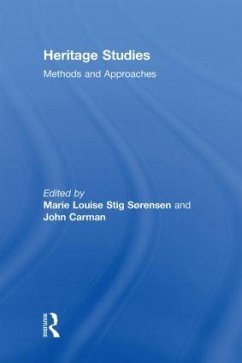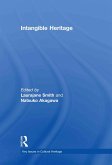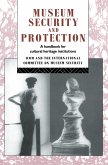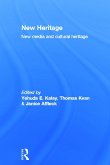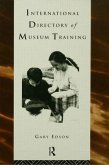Heritage Studies
Methods and Approaches
Herausgeber: Sørensen, Marie Louise Stig; Carman, John
Heritage Studies
Methods and Approaches
Herausgeber: Sørensen, Marie Louise Stig; Carman, John
- Gebundenes Buch
- Merkliste
- Auf die Merkliste
- Bewerten Bewerten
- Teilen
- Produkt teilen
- Produkterinnerung
- Produkterinnerung
Deals with the consolidation and clarification of Heritage Studies as a distinct field with its own means of investigation. This title presents the range of methods that can be used and illustrates their application through case studies from different parts of the world, including the UK and USA.
First Published in 2008. Routledge is an imprint of Taylor & Francis, an informa company.
Andere Kunden interessierten sich auch für
![Intangible Heritage Intangible Heritage]() Natsuko Akagawa / LAURAJANE SMITH (eds.)Intangible Heritage184,99 €
Natsuko Akagawa / LAURAJANE SMITH (eds.)Intangible Heritage184,99 €![Museum Security and Protection Museum Security and Protection]() Museum Security and Protection182,99 €
Museum Security and Protection182,99 €![Museums and the Shaping of Knowledge Museums and the Shaping of Knowledge]() Eileen Hooper GreenhillMuseums and the Shaping of Knowledge182,99 €
Eileen Hooper GreenhillMuseums and the Shaping of Knowledge182,99 €![New Heritage New Heritage]() Jane Affleck / Yehuda Kalay / Thomas Kvan (eds.)New Heritage184,99 €
Jane Affleck / Yehuda Kalay / Thomas Kvan (eds.)New Heritage184,99 €![International Directory of Museum Training International Directory of Museum Training]() Gary EdsonInternational Directory of Museum Training175,99 €
Gary EdsonInternational Directory of Museum Training175,99 €![On Collecting On Collecting]() Susan PearceOn Collecting184,99 €
Susan PearceOn Collecting184,99 €![Places of Pain and Shame Places of Pain and Shame]() Places of Pain and Shame184,99 €
Places of Pain and Shame184,99 €-
-
-
Deals with the consolidation and clarification of Heritage Studies as a distinct field with its own means of investigation. This title presents the range of methods that can be used and illustrates their application through case studies from different parts of the world, including the UK and USA.
First Published in 2008. Routledge is an imprint of Taylor & Francis, an informa company.
First Published in 2008. Routledge is an imprint of Taylor & Francis, an informa company.
Produktdetails
- Produktdetails
- Verlag: Taylor & Francis Ltd (Sales)
- Seitenzahl: 360
- Erscheinungstermin: 1. September 2009
- Englisch
- Abmessung: 240mm x 164mm x 22mm
- Gewicht: 629g
- ISBN-13: 9780415431842
- ISBN-10: 0415431840
- Artikelnr.: 23820259
- Herstellerkennzeichnung
- Libri GmbH
- Europaallee 1
- 36244 Bad Hersfeld
- gpsr@libri.de
- Verlag: Taylor & Francis Ltd (Sales)
- Seitenzahl: 360
- Erscheinungstermin: 1. September 2009
- Englisch
- Abmessung: 240mm x 164mm x 22mm
- Gewicht: 629g
- ISBN-13: 9780415431842
- ISBN-10: 0415431840
- Artikelnr.: 23820259
- Herstellerkennzeichnung
- Libri GmbH
- Europaallee 1
- 36244 Bad Hersfeld
- gpsr@libri.de
Marie Louise Stig Sørensen, John Carman
Part 1: Setting the Scene 1. Introduction: Making the Means Transparent:
Reasons and Reflections 2. Heritage Studies - An Outline 3. Public
Archaeology in United States in the Early Twenty-First Century Part 2:
Heritage Methodologies: Investigating Texts 4. The History of Heritage: A
Method in Analyzing Legislative Historiography 5. Means Maketh the End -
The Context for the Development of Methodologies to Assessing the State of
the Historic Environment in the UK 6. Methods Used to Investigate the Use
of the Past in the Formation of Regional Identities Part 3: Heritage
Methodologies: Investigating People 7. Reflections on the Practice of
Ethnography Within Heritage Tourism 8. Heritage Ethnography as a
Specialised Craft: Grasping Maritime Heritage in Bermuda 9. Between the
Lines and in the Margins: Interviewing People About Attitudes to Heritage
and Identity 10. Walking a Fine Line: Obtaining Sensitive Information Using
a Valid Methodology 11. Methods for Investigating Locals' Perceptions of a
Cultural Heritage Product for Tourism: Lessons from Botswana Susan 12. The
Public Archaeology of African America: Reflections on Pragmatic Methods and
their Results Part 4: Heritage Methodologies: Investigating Things 13. The
Use of GIS in Landscape Heritage and Attitudes to Place-Digital Deep Maps
14. Making them Draw: The Use of Drawings in Research into Public Attitudes
Towards the Past 15. The Heritagescape: Looking at Heritage Sites 16. The
Intangible Presence: Investigating Battlefields Part 5: Commentaries
Commentary: the View from Social Anthropology Commentary: The View from
Environmental Psychology
Reasons and Reflections 2. Heritage Studies - An Outline 3. Public
Archaeology in United States in the Early Twenty-First Century Part 2:
Heritage Methodologies: Investigating Texts 4. The History of Heritage: A
Method in Analyzing Legislative Historiography 5. Means Maketh the End -
The Context for the Development of Methodologies to Assessing the State of
the Historic Environment in the UK 6. Methods Used to Investigate the Use
of the Past in the Formation of Regional Identities Part 3: Heritage
Methodologies: Investigating People 7. Reflections on the Practice of
Ethnography Within Heritage Tourism 8. Heritage Ethnography as a
Specialised Craft: Grasping Maritime Heritage in Bermuda 9. Between the
Lines and in the Margins: Interviewing People About Attitudes to Heritage
and Identity 10. Walking a Fine Line: Obtaining Sensitive Information Using
a Valid Methodology 11. Methods for Investigating Locals' Perceptions of a
Cultural Heritage Product for Tourism: Lessons from Botswana Susan 12. The
Public Archaeology of African America: Reflections on Pragmatic Methods and
their Results Part 4: Heritage Methodologies: Investigating Things 13. The
Use of GIS in Landscape Heritage and Attitudes to Place-Digital Deep Maps
14. Making them Draw: The Use of Drawings in Research into Public Attitudes
Towards the Past 15. The Heritagescape: Looking at Heritage Sites 16. The
Intangible Presence: Investigating Battlefields Part 5: Commentaries
Commentary: the View from Social Anthropology Commentary: The View from
Environmental Psychology
Part 1: Setting the Scene 1. Introduction: Making the Means Transparent:
Reasons and Reflections 2. Heritage Studies - An Outline 3. Public
Archaeology in United States in the Early Twenty-First Century Part 2:
Heritage Methodologies: Investigating Texts 4. The History of Heritage: A
Method in Analyzing Legislative Historiography 5. Means Maketh the End -
The Context for the Development of Methodologies to Assessing the State of
the Historic Environment in the UK 6. Methods Used to Investigate the Use
of the Past in the Formation of Regional Identities Part 3: Heritage
Methodologies: Investigating People 7. Reflections on the Practice of
Ethnography Within Heritage Tourism 8. Heritage Ethnography as a
Specialised Craft: Grasping Maritime Heritage in Bermuda 9. Between the
Lines and in the Margins: Interviewing People About Attitudes to Heritage
and Identity 10. Walking a Fine Line: Obtaining Sensitive Information Using
a Valid Methodology 11. Methods for Investigating Locals' Perceptions of a
Cultural Heritage Product for Tourism: Lessons from Botswana Susan 12. The
Public Archaeology of African America: Reflections on Pragmatic Methods and
their Results Part 4: Heritage Methodologies: Investigating Things 13. The
Use of GIS in Landscape Heritage and Attitudes to Place-Digital Deep Maps
14. Making them Draw: The Use of Drawings in Research into Public Attitudes
Towards the Past 15. The Heritagescape: Looking at Heritage Sites 16. The
Intangible Presence: Investigating Battlefields Part 5: Commentaries
Commentary: the View from Social Anthropology Commentary: The View from
Environmental Psychology
Reasons and Reflections 2. Heritage Studies - An Outline 3. Public
Archaeology in United States in the Early Twenty-First Century Part 2:
Heritage Methodologies: Investigating Texts 4. The History of Heritage: A
Method in Analyzing Legislative Historiography 5. Means Maketh the End -
The Context for the Development of Methodologies to Assessing the State of
the Historic Environment in the UK 6. Methods Used to Investigate the Use
of the Past in the Formation of Regional Identities Part 3: Heritage
Methodologies: Investigating People 7. Reflections on the Practice of
Ethnography Within Heritage Tourism 8. Heritage Ethnography as a
Specialised Craft: Grasping Maritime Heritage in Bermuda 9. Between the
Lines and in the Margins: Interviewing People About Attitudes to Heritage
and Identity 10. Walking a Fine Line: Obtaining Sensitive Information Using
a Valid Methodology 11. Methods for Investigating Locals' Perceptions of a
Cultural Heritage Product for Tourism: Lessons from Botswana Susan 12. The
Public Archaeology of African America: Reflections on Pragmatic Methods and
their Results Part 4: Heritage Methodologies: Investigating Things 13. The
Use of GIS in Landscape Heritage and Attitudes to Place-Digital Deep Maps
14. Making them Draw: The Use of Drawings in Research into Public Attitudes
Towards the Past 15. The Heritagescape: Looking at Heritage Sites 16. The
Intangible Presence: Investigating Battlefields Part 5: Commentaries
Commentary: the View from Social Anthropology Commentary: The View from
Environmental Psychology

